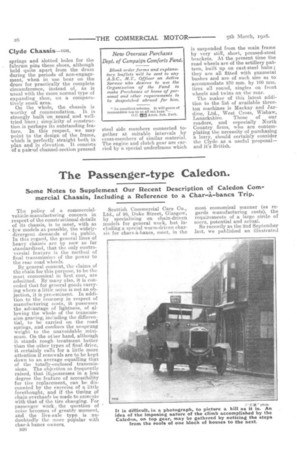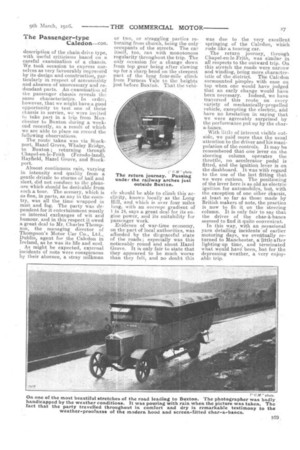The Passenger-type Caledon.
Page 6

Page 7

If you've noticed an error in this article please click here to report it so we can fix it.
Some Notes to Supplement Our Recent Description of Caledon Commercial Chassis, Including a Reference to a Char-a-bancs Trip.
The policy oE a commercialvehicle-manufacturing concern respect of the constructional details of its chassis, is to meet, with as few models as possible, the widelydivergent demands of its public. In this regard, the general lines of heavy chassis are by now so far standardized, that the only controversial feature is the method of final transmissioa of the power to the rear road wheels.
By general consent, the claims of the chain for this purpose, to be the most economical in first cost, are admitted. By ninny also, it is conceded that for general goods carrying where a little noise is not an objection, it is .pre-eminent. In addition to the economy in respect of manufacturing costs, it possesses the advantage of lightness, of allowing the whole of the transmission gearing, incLuding the differential, to be carried on the road springs, and confines the unsprung weight to the unavoidable minimum. On the other hand, although it stands rough treatment better than the other types of final drive, it certainly calls for a little more attention if renewals are to be kept down to an average equalling that of the totally-enclosed transmissions. The objrction so frequently raised, that itspossesses in a less degree the feature of accessibility for tire replacement, can be discounted by the exercise of a little forethought, and if the timing 0' chain overhauh3 he made to coincide with that of the tire. changing. For passenger work: the question of ' noise becomes of. greatEr moment, and the live-axle type. is .undoubtedly the more poliular with char-a banes owners.
n20 Scottish Commercial Cars Co., Ltd., of 98, Duke Street, Glasgow, by specializing on chain-driven models for general work, but including a special worm-driven chassis for chars-k-bancs, meet, in the most economical manner (as regards manufacturing costs), the requirements of a large circle of users, potential and actual. So recently as the 2nd September last, we published an illustrated
description of the chain-drive type, with useful criticisms based on a careful examination of a chassis. We took occasion to express ourselves as very favourably impressed by its design and construction, particularly in respect of accessibility and absence of unnecessary and redundant parts. An examination of the passenger chassis reveals the same characteristics. In order, however, that we might have a good opportunity to test one of these chassis in service, we were invited to take part in a trip from Manchester to Buxton during a weekend recently, as a result of which we are able to place on record the following observations.
The route taken was via Stockport, Hazel Grove, Whaley Bridge, to Buxton ; returning through Chapel-en-le-Frith (Ferodo-land), Hayfield, Hazel Grove, and Stockport.
Almost continuous rain, varying in intensity and quality from a gentle drizzle to storms of hail and sleet, did not conduce to the pleasure which should be derivable from such a tour. The scenery, which is as fine, in parts, as any in the country, was all the time wrapped in mist and fog. The party was dependent for it entertainment mostly on internal exchanges of wit and humour, and in this respect it owed a great deal to Mr. Charles Thompson, the managing director of Thompson's Motor Car Co., Ltd., Dublin, agent for the Caledon in Ireland, as he was its life and soul; As might be expected, external incidents of note were conspicuous by their absence, a stray milkman or two, or straggling parties returning from church, being the only occupants of the streets. The car itself, too, ran with monotonous regularity throughout the trip. The only occasion for a change down from top gear being after slowing up for a sharp bend on the steepest part of the long four-mile climb from Furness Vale to the heights just before Buxton. That the' vehi
ele should be able to climb this acclivity, known locally as the Long Hill, and which is over four miles long, with an average gradient of 1 in 18, says a great deal for its engine power, and its suitability for passenger work.
Evidence of war-time economy, on the part of local authorities, was afforded by the diEgraceful state of the roads ; especially was this noticeable round and about Hazel Grove. It is only fair to state that they appeared to be much worse than they felt, and no doubt this was due to the very excellent springing of the Caledon, • which rode like a touring car.
The return journey, through Chapel-en-le-Frith, was similar in all respects to the outward trip. On this stretch the roads were narrow and winding, being more character istic of the district. The Caledon
surmounted pimples with ease on -top when one would have judged
that an early change would have been necessary. Indeed, we have traversed this route on every
• -variety of mechanically-propelled vehicle, excepting the electric, and
have no hesitation in saying that we were agreeably surprised by the performance put up by the chara-banes.
With little of interest visible outside, we Paid more than the usual 'attention to the driver and his manipulation of the controls. It may he remembered that one lever on the steering column operates the throttle, no accelerator pedal is fitted, and the ignition lever is on the dashboard. It was with regard to the use of the last fitting that we were curious. The positioning of the lever here is as old as electric ignition for automobiles, but, with the exception of one other ehassis, at least so far as those made by British makers of note, the practice is now to fit it on the steering column. It is only fair to say that the driver of the char-hebancs seemed to find it quite convenient. In this way, with an ,occasional yarn detailing incidents'of earlier motoring days, we eventually re turned to Manchester, alittle after lighting-up time, and terminated what would havd been, but for the depressing weather, a very enjoyable trip.






















